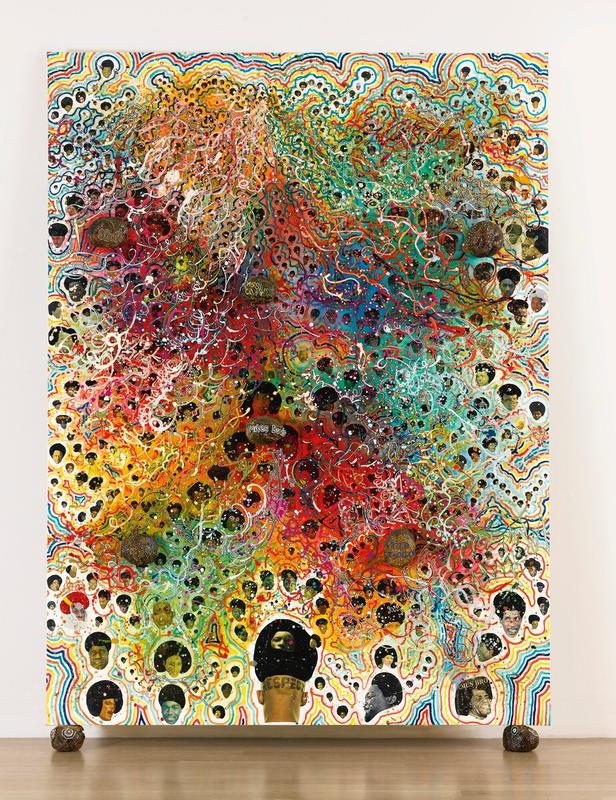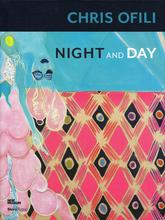More about Afrodizzia
- All
- Info
- Shop

Contributor
Chris Ofili’s Afrodizzia is a mashup of historical Black figures, elephant dung, and afros.
You take one look at this painting, and you instantly like it; you may not know exactly what you’re looking at, but it’s nice to look at. The colors pop, the lines are trippy, and it even has a little poop on there to give it a quirky feel. But at its core, it’s all hip-hop. No, there’s no catchy chorus or silent beat, but the essence of hip-hop is definitely on display. The painting is made up of cutouts of famous Black people like Miles Davis, James Brown, Muhammad Ali, Diana Ross, and Nelson Mandela, to name a few. Plastered on each famous head is an afro that’s been cut out from a separate photographic source. The afros don’t always look natural, either. It seems to be Ofili’s intention to make them disproportionate and askew. Each head is then placed in a seemingly random spot on a canvas that was painted to resemble what it probably looked like to drop acid in the seventies. Arbitrarily set within the canvas are gobs of elephant dung, which is also what props the painting upright.
This is the part where you start to seriously doubt my analysis skills. You don’t think any of this sounds like hip-hop, or that none of these things even have anything to do with each other. But that’s precisely the point. That’s exactly what hip-hop is. It’s borrowing from multiple sources and combining each little piece to make something wholly unique. So, no. This painting is not a song. But conceptually, it’s everything that makes that genre so popular.
The inclusion of famous Black figures is clearly a celebration of what Black people have accomplished throughout history. Each person is recognizable, and a list of their numerous accomplishments bubbles to the surface of your mind when you look at them. Adding an afro to each person’s head also raises awareness for the viewer. We all know what an afro is. But Black hair is some of the most exploited and vilified parts of Black culture, especially historically. So the inclusion of the afros, in the haphazard way that they are conveyed, could be Ofili trying to remind his audience of just how impressive these people's achievements, considering the formidable obstacles they faced.
The title of the work, Afrodizzia, is a play on the word aphrodisiac, which is something that can be taken to jump-start your sex drive. This reference to an aphrodisiac points to the troubled history between Blackness and sexual desire as it exists in a systemically racist world. Between the psychedelic colors and afro hairstyles, the work also conjures to mind Blaxploitation films of the 1970s, a controversial genre known for both celebrating Black culture and reinforcing negative stereotypes.
Finally, even the elephant dung has a deeper meaning. Many of us look at it and just see a giant ball of poop. But elephants are important to the African continent, where all Black Americans originate, and where all human life started. Poop specifically is something that’s used in fertilizer to grow things from the dirt. When you take that into consideration, and combine it with the fact that it’s the elephant dung that props this painting up, I don’t think it’s a stretch to say that it represents Black roots.
It’s part collage, part Black celebration, part exploitation, and part poop. If that’s not hip-hop. I don’t know what is. Each little piece points to one particular topic, but when you mash them together, it creates something truly profound. The very essence of this painting is hip-hop. Something that was originated by Black people, and is continually innovated by Black people. To reference its existence is a nod of respect to something that’s given back to its people and the world.
Sources
- The Art Story. “Chris Ofili Artworks.” Accessed January 18, 2021. https://www.theartstory.org/artist/ofili-chris/artworks/#nav
- Kunitz, Daniel. “True” Sensation.” Salon. October 2, 1999. https://www.salon.com/1999/10/02/dung/
- St. Félix, Doreen. “Chris Ofili’s Frustrating, Profound “Paradise Lost.” The New Yorker. October 5, 2017. https://www.newyorker.com/culture/culture-desk/chris-ofilis-frustrating…












